Object of the Month: February 2017
Christ before Pilate
Oil on panel
Master of St. Severin
German, active c. 1485–1515
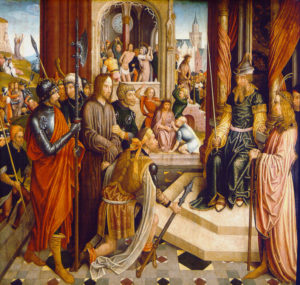
Click on the links throughout the article to view additional artists’ works and reference material.
Little background history exists for the artist referred to as the Master of St. Severin. While scholars remain uncertain as to his identity, they have confidently identified a body of works they believe to be by his hand. The Church of St. Severin houses what are considered his best works, thus he became known by the pseudonym, the Master of St. Severin. His body of work primarily reflects oil paintings on panel, however, there is some indication that he might have also designed and produced stained glass windows.
Christ before Pilate brings together several of the events of the Passion Week leading to the crucifixion of Christ. He did a similar work called Passion Scene: Christ at the Mount of Olives. Both works embody his style evidenced in the stiffness of the figures and the similarity in facial features and expressions of all figures. In the foreground of M&G’s work, a solemn and calm Christ appears before Pilate for trial. The surrounding miniature scenes reveal the events preceding and following his trial. To the left in the distant background, the artist portrays Christ’s prayer and arrest in the Garden of Gethsemane along with Peter cutting off Malchus’ ear. Centrally located in the background and enclosed in a cathedral-like structure, Christ receives beating with the cat of nine tails and then just below He is crowned with a ring of thorns. Finally, to the far back right, Pilate presents Christ to the Jews.
Beautifully detailed in oil, the painting provides a window into the culture of the artist. Click the dropdown below to learn more about the clothing featured by the Master of St. Severin.
Dagging is cutting the edges of garments, hangi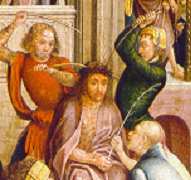 ng sleeve flaps, or even hats into pointed or squared scallops. This trend was especially popular during the late Middle Ages. The man in red at Christ’s crowning with thorns features dagging at the bottom of his doublet (jacket).
ng sleeve flaps, or even hats into pointed or squared scallops. This trend was especially popular during the late Middle Ages. The man in red at Christ’s crowning with thorns features dagging at the bottom of his doublet (jacket).
Also known as crakowes, these were an elongated, exaggeratedly pointed-toed shoe often worn by nobles or the wealthy. King Edward III 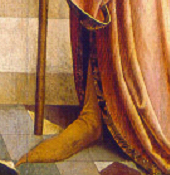 tried to take matters into his own hands by declaring a law that “no Knight under the estate of a lord, esquire or gentleman, nor any other person, shall wear any shoes or boots having spikes or points exceeding the length of two inches, under the forfeiture of forty pence.” The law was ineffective, and the trend lasted until 1480! The man, at right foreground and near to Pilate, models poulaines.
tried to take matters into his own hands by declaring a law that “no Knight under the estate of a lord, esquire or gentleman, nor any other person, shall wear any shoes or boots having spikes or points exceeding the length of two inches, under the forfeiture of forty pence.” The law was ineffective, and the trend lasted until 1480! The man, at right foreground and near to Pilate, models poulaines.
These were a special non-functional, decorative sleeve attached to the jacket; in the early Renaissance, they were mostly us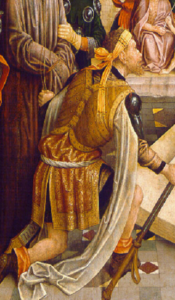 ed for ceremonial occasions as seen here on the soldier kneeling in the foreground.
ed for ceremonial occasions as seen here on the soldier kneeling in the foreground.
Parti-colored is the sewing together sections of different colored fabrics within the same garment. This was used in both men’s and women’s clothing and could reflect the colors of a particular city or families joined in marriage. The man kneeling in front of Christ at his crowning with t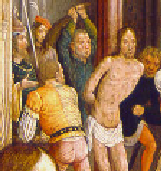 horns features
horns features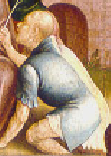 a parti-colored doublet. At the beating of Christ, the man to the left of Christ also wears a parti-colored doublet.
a parti-colored doublet. At the beating of Christ, the man to the left of Christ also wears a parti-colored doublet.
Rebekah Cobb, Guest Relations Manager
Published in 2017